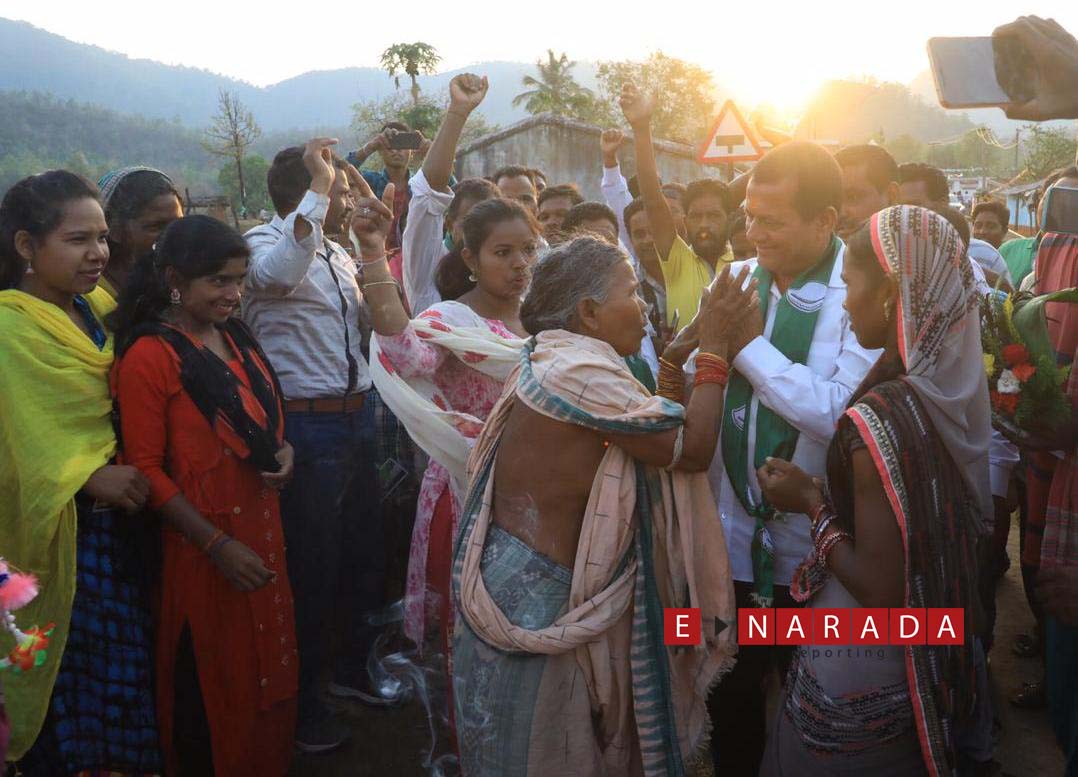ENARADA, New Delhi
By Ajay N Jha
One phrase that surfaces mostly before and after any state or Lok Sabha elections in India is anti- incumbency and it starts getting used by politicians as well as political pundits and pontiffs “ad nauseum’ either to score a point or to pillory the opponent.
An anti-incumbent vote is one exercised against elected officials currently in power. It allows the voters to register their discontent with sitting government officials, particularly when protesting against certain actions taken by the government or the elected officials in question.
Anti-incumbency is any such urge or means to throw the schmuck in power out of the office.
Anti-incumbency has always played a major role. It’s like there are always two major players in a state, one of them screws his/her chances during their term and the other one automatically gets the benefit of doubt. The expectation is that the years out of power will have taught the loser a lesson and that it will behave better the second time around. With all the increased flexibility of the polling process, a huge turnout generally means reappearance of the faces (including the sons and daughters of those faces if they did not get the ticket for some reasons) that lost 5 years ago. Long gone are the days when “Good Vs Evil” or David Vs Goliath kind of battles used to take place.
There have been a few exceptions, notably Nitish Kumar in Bihar and Naveen Patnaik in Odisha, whose performances in office have enabled them to beat the anti-incumbency factor. Or Tarun Gogoi in Assam, who has been chief minister thrice because he doesn’t face a credible opposition. But other than that, the Indian electorates have and will always be forced to choose the lesser of the two evils (if one is a Satan, the other can be best described as a Leviathan).
Other than that, anti- incumbency did play its role in some measure or the other against the party. But the latest Assembly elections in Chhattisgarh appears to have re-defined the term. Interestingly, in Chhattisgarh-the majority of the sitting MLAs belonging to both the parties— 49 out of 90 — lost. The incumbency factor was against the candidates, not the party. In 25 seats Congress won at the cost of the BJP and gave away 22 other to the BJP. The new house has 34 new faces from both the parties.
In his first comment to the media after his party narrowly missed the target, the state Congress president, Charan Das Mahant talked about an “internal sabotage” which he said needs to be investigated. Other leaders from the organisation, mostly those who lost, repeated the charge later and flew off to Delhi to complain. It was quiet obvious that there would be some substantial reasons to find out how 27 sitting Congress MLAS lost elections and whether Ajit Joigi would have been so powerful enough to decimate them in one go. Or, it was that they found a readymade punching bag in Jogi and could get away even with their own inability and incompetence in his name?
Internal sabotage is another catchy phrase that helps politicians shift the blame on rivals both from inside and outside and it is not new to political parties in our country. In a political metaphor, it is perhaps as common a malady as catching cold. In any case, Sabotage, however, cannot be the only reason for a party’s defeat or of that of more than half the total strength of the assembly. Money and muscle power, inducements in various forms before and during the elections and caste equations are some of the other important factors that go into the making of a result.
According to a few Congress leaders, Ajit Joghi had held a press conference in 2008, a few days before the polling date and mentioned 7 persons whom he was going to defeat and all of them lost. The Congress party’s score was 38 out of 90. In 2013, it has been just 39 seats. That means, traditions of trail and betrayals were followed in 2013 too. In case of the Congress candidates, a more credible explanation for their defeat certainly has a lot to do with their role as opposition members in the last decade — a responsibility in which they failed miserably. “The Congress was noticed more for the lack of a firm stand in favour of the issues concerning people’s interest and for its soft opposition to the government of the day” said a prominent commentator from Raipur.
He listed endless instances where the Congress failed miserably to live up to the role of an honest opposition and force the government to the dock or seek explanations from it. Like in case of the rape of tribal school girls in a government hostel in Jhaliamari in Bastar early this year, or the series of government sponsored eye-camps where a hundred of villagers went blind due to spurious and adulterated medicines in ill-equipped hospitals, or an instance last year where an under trial, accused of murders, succeeded in hijacking a train between Bhilai and Raipur and eloping.
This should have raised an alarm on the absence or failure of the law and order machinery — an issue that came up in focus almost fleetingly after the killing of the Congress leaders at the hand of the Maoists. No wonder the opposition was derisively referred to as the B-team of the ruling party. The leaders of the opposition Congress in 2008 and 2013 — both had enjoyed the rank of a cabinet minister with perquisites that go with it —were defeated at the end of their terms.
A new factor, most conspicuous and apparently valid in the plethora of hypotheses explaining the vote for change that seems to have affected the results decisively in 2013 in a state rich in natural resources is the effects of the drive to industrialise the state. Just one district of the state — Champa-Janjgir — alone holds the distinction of being the district with the highest proposed thermal power capacity addition in the whole country.
Its neighbour, the Raigarh district follows a close second. Between the two, at least 55,000 Megawatts (MW) of coal-based thermal power generation is in the pipeline. This massive spree of thermal power plant construction has resulted in a colossal displacement of the farmers and has shaken the foundations of the agro based economy of the area with ripples reaching far beyond it. “One megawatt of capacity generation eats up 80 acres of land. This includes land required for mining, for creating reservoirs, for disposal of ash and for installation of the transmission lines and the project itself” says the activist Gautam Bandopadhyay of the Nadi Ghati Morcha as quoted in a local Hindi newspaper.
The fight for survival of the villager is not limited to land. The Mahanadi system drains over 90% of the geography in the state. “The construction of bumper to bumper barrages and anicuts in it has brought lakhs of water and river dependent communities in direct conflict with the state over control of this natural resource” says Shripad Dharmadhikary who coordinates the Manthan Adhyanan Kendra, a Badwani (MP) based centre that researches, analyses and monitors water and energy issues.
An old dam in Jangir district — Rigda Dam — that was benefiting irrigation was sold off to an industry. The Vidhan Sabha set up an inquiry committee consisting of members of both the parties. It collapsed into a farce. Almost all the members involved with it lost in 2013. Close to 5000-6000 families mostly landless — are estimated to be dependent on the riverbed cultivation in the stretch of 50 km in Janjgir Champa district alone.
The obvious question that senior leaders of both BJP and Congress have been dodging is as to what have the people’s representatives been doing in all these years? No honest voice was raised in the assembly, no questions were asked, and no one came out to fight the people’s cause. The perception of the MLAs being in the payroll of the industries grew by the day. The MLAs were clearly seen standing on the other side of the fence and voters were waiting for their chance to answer them with ballots.
Consequent results were loud and clear. All the 9 sitting MLAs of both the parties in these two districts and lost heavily — Raigarh and Dharamjaigarh by 20000, Lailunga by 15000, Akaltara by 22000 and so on. The Chandrapur MLA Yuddha Vir Singh who came out to attend public hearings and supported the villagers was an exception and he won by a handsome margin as well.
The BJP, on the other hand, did not crib about sabotage in public but lost no time in starting expulsions of party men on charges/suspicion of sabotage. Senior leaders in Dantewada were the firsts in the list
The BJP had gone into the election with the slogan “fir Raman, fir Kamal”. The party had placed its faith on the Raman Singh brand to clinch an easy win – third time in a row in Chhattisgarh. There were times when BJP’s confidence in its own potential wavered, especially on the counting day and a cloud of doubt could clearly be seen on his face when he was interacting with the media. Following the first phase of polling, news from the Bastar region that the party might be losing to Congress was cause for serious concern. After the first phase of polling was over on 11th November, the news filtering out of Bastar had left the party worried. Very heavy polling (over 75 percent, with 80 percent polling in five segments) in the first phase of the elections and ideas floating around that things were not exactly going great with the BJP was enough to rattle the senior leadership. So following a quick mid-poll review, Narendra Modi’s charms were summon to revive the Chhattisgarh poll campaign. He was made more visible in the ad campaigns and was made to address more rallies than previously planned – Modi attended nine meetings in two days.
This anti-incumbency was equally visible in a few areas where even Modi’s nationwide appeal and charishma could not save the BJP candidates. The BJP poll managers had arranged a total of 12 meeting of Narendra modi as a part of what it called ‘ carpet Bombing strategy” and they had hoped that Modi’s magic and his presence would not only ensure those seats but it would also have the cascading impact in neighboring areas. Results from Chhattishgarh clearly established that BJP candidates lost at all those places where Modi’s rally had been organized including kanker, Korba, Gurg city, Bilha, Mahasamund and Raipur rural assembly segments.
In Bastar region also, Modi had addressed two rallies and the BJP ended up losing 7 seats out of 12. In last elections, BJP had won 11 out of 12 seats from this region. Even in Sarguja region, Modi had addressed a big rally at Ambikapur but BJP could manage to win only one seat out of the total of 8 seats in undivided Sarguja district.
Yet the BJP managed to win the assembly polls. That underlined the fact that anti-incumbency was against individual candidates and not the party per se.
A critical examination of the poll results can clearly establish a few things. Firstly, the BJP’s fears about Bastar were not completely unfounded.
Of the 18 seats that had gone into polls in the region, Congress kept 12 while the BJP bagged just six. However, the fact that BJP still won the polls in Chhattisgarh proves that the importance of Bastar in the overall outcome in the state’s polls has been grossly overrated.
Secondly, the doubts that were raised about Raman Singh’s achievements were highly misplaced. Raman Singh has won decisively. But several of his ministers – almost half the cabinet – have lost.
The list includes some important names in Chhattisgarh politics – Nanki Ram Kanwar, the home minister from Rampur, Ram Vichar Netam, the law minister from Samri, Chandra Shekhar Sahu (Agriculture) from Abhanpur, and Hem Chandra Yadav from Durg. Many of the BJP candidates who won, were in fact, rank newcomers. So it is evident that the voters placed their trust in Raman Singh who had campaigned intensively in these constituencies but hated some of BJP MLAS who had failed to keep their promises and defeated them with big margins.
The Chhattisgarh results also explain the significance of higher percentage of women voters casting their votes. Women benefitted greatly from the distribution of new and revised ration cards, where their names appeared as the head of the family. In 55 out of the 90 seats, women voted more than the men. In those 44 seats where over 80 percent votes were cast, benefitted BJP as most of these seats have gone to BJP.
Another take-away from this poll result is the fact that the killing of the Congress leaders in a Maoist attack in Darbha generated sympathy for the Congress, but not enough to win them an election.
In fact the frustration about the Maoist insurgency generated a whole bunch of NOTA votes in Bastar. In Chitrakot in Bastar, for example, the number of NOTA votes stood at 10,848. In Dantewada where the widow of the slain leader Mahendra Karma got elected, the number of NOTA votes were 9677. The number of NOTA votes have been uniformly higher in all the Bastar seats.
Though people came out to vote in large numbers in the Maoist affected regions of Bastar, votes deflected from both the Congress and the BJP and went to NOTA.
That might be food for thought for Raman Singh as he has started his third term. More than that however, it would be a big warning signal for politicians going to contest 2014 Lok Sabha polls that NOTA may be used in a big way.
(Posted on December 15, 2013 @ 6pm)
(Ajay N Jha is a veteran journalist from both Print and Electronic media. He is Advisor to Prasar Bharti. The views expressed are his personal. His email id is Ajay N Jha <ajayjha30@gmail.com> )
The views expressed on the website are those of the Columnists/ Authors/Journalists / Correspondents and do not necessarily reflect the views of ENARADA.










